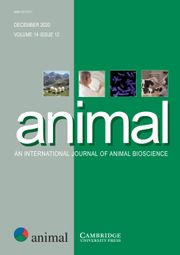Crossref Citations
This article has been cited by the following publications. This list is generated based on data provided by
Crossref.
Saddiqi, H.A.
Sarwar, M.
Iqbal, Z.
Nisa, M.
and
Shahzad, M.A.
2012.
Markers/parameters for the evaluation of natural resistance status of small ruminants against gastrointestinal nematodes.
Animal,
Vol. 6,
Issue. 6,
p.
994.
Sallé, G.
Jacquiet, P.
Gruner, L.
Cortet, J.
Sauvé, C.
Prévot, F.
Grisez, C.
Bergeaud, J. P.
Schibler, L.
Tircazes, A.
François, D.
Pery, C.
Bouvier, F.
Thouly, J. C.
Brunel, J. C.
Legarra, A.
Elsen, J. M.
Bouix, J.
Rupp, R.
and
Moreno, C. R.
2012.
A genome scan for QTL affecting resistance to Haemonchus contortus in sheep1.
Journal of Animal Science,
Vol. 90,
Issue. 13,
p.
4690.
Riggio, V
Matika, O
Pong-Wong, R
Stear, M J
and
Bishop, S C
2013.
Genome-wide association and regional heritability mapping to identify loci underlying variation in nematode resistance and body weight in Scottish Blackface lambs.
Heredity,
Vol. 110,
Issue. 5,
p.
420.
Venturina, Virginia M.
Gossner, Anton G.
and
Hopkins, John
2013.
The immunology and genetics of resistance of sheep to Teladorsagia circumcincta.
Veterinary Research Communications,
Vol. 37,
Issue. 2,
p.
171.
Karrow, Niel A.
Goliboski, Katherine
Stonos, Nancy
Schenkel, Flavio
and
Peregrine, Andrew
2014.
Review: Genetics of helminth resistance in sheep.
Canadian Journal of Animal Science,
Vol. 94,
Issue. 1,
p.
1.
Riggio, V.
Pong‐Wong, R.
Sallé, G.
Usai, M.G.
Casu, S.
Moreno, C.R.
Matika, O.
and
Bishop, S.C.
2014.
A joint analysis to identify loci underlying variation in nematode resistance in three European sheep populations.
Journal of Animal Breeding and Genetics,
Vol. 131,
Issue. 6,
p.
426.
Riggio, V.
Abdel-Aziz, M.
Matika, O.
Moreno, C.R.
Carta, A.
and
Bishop, S.C.
2014.
Accuracy of genomic prediction within and across populations for nematode resistance and body weight traits in sheep.
Animal,
Vol. 8,
Issue. 4,
p.
520.
Valilou, Rahman Hajializadeh
Rafat, Seyed A.
Notter, David R.
Shojda, Djalil
Moghaddam, Gholamali
and
Nematollahi, Ahmad
2015.
Fecal egg counts for gastrointestinal nematodes are associated with a polymorphism in the MHC-DRB1 gene in the Iranian Ghezel sheep breed.
Frontiers in Genetics,
Vol. 6,
Issue. ,
Atlija, Marina
Arranz, Juan-Jose
Martinez-Valladares, María
and
Gutiérrez-Gil, Beatriz
2016.
Detection and replication of QTL underlying resistance to gastrointestinal nematodes in adult sheep using the ovine 50K SNP array.
Genetics Selection Evolution,
Vol. 48,
Issue. 1,
Moore, Hope
Pandolfi, Fanny
and
Kyriazakis, Ilias
2016.
Familiarity with and uptake of alternative methods to control sheep gastro-intestinal parasites on farms in England.
Veterinary Parasitology,
Vol. 221,
Issue. ,
p.
1.
Sweeney, T.
Hanrahan, J. P.
Ryan, M. T.
and
Good, B.
2016.
Immunogenomics of gastrointestinal nematode infection in ruminants – breeding for resistance to produce food sustainably and safely.
Parasite Immunology,
Vol. 38,
Issue. 9,
p.
569.
Zvinorova, P.I.
Halimani, T.E.
Muchadeyi, F.C.
Matika, O.
Riggio, V.
and
Dzama, K.
2016.
Breeding for resistance to gastrointestinal nematodes – the potential in low-input/output small ruminant production systems.
Veterinary Parasitology,
Vol. 225,
Issue. ,
p.
19.
Fomum, Sylvester W.
and
Nsahlai, Ignatius V.
2017.
In vitro control of parasitic nematodes of small ruminants using some plant species containing flavonoids.
Tropical Animal Health and Production,
Vol. 49,
Issue. 2,
p.
375.
Skallerup, Per
Nejsum, Peter
Cirera, Susanna
Skovgaard, Kerstin
Pipper, Christian B.
Fredholm, Merete
Jørgensen, Claus B.
and
Thamsborg, Stig M.
2017.
Transcriptional immune response in mesenteric lymph nodes in pigs with different levels of resistance to Ascaris suum.
Acta Parasitologica,
Vol. 62,
Issue. 1,
Keane, O. M.
Hanrahan, J. P.
McRae, K. M.
and
Good, B.
2018.
An independent validation study of loci associated with nematode resistance in sheep.
Animal Genetics,
Vol. 49,
Issue. 3,
p.
265.
Dlamini, N.M.
Visser, C.
Snyman, M.A.
Soma, P.
and
Muchadeyi, F.C.
2019.
Genomic evaluation of resistance to Haemonchus contortus in a South African Dohne Merino flock.
Small Ruminant Research,
Vol. 175,
Issue. ,
p.
117.
Cunha, Samla Marques Freire
Lam, Stephanie
Mallard, Bonnie
Karrow, Niel A.
and
Cánovas, Ángela
2024.
Genomic Regions Associated with Resistance to Gastrointestinal Nematode Parasites in Sheep—A Review.
Genes,
Vol. 15,
Issue. 2,
p.
187.

